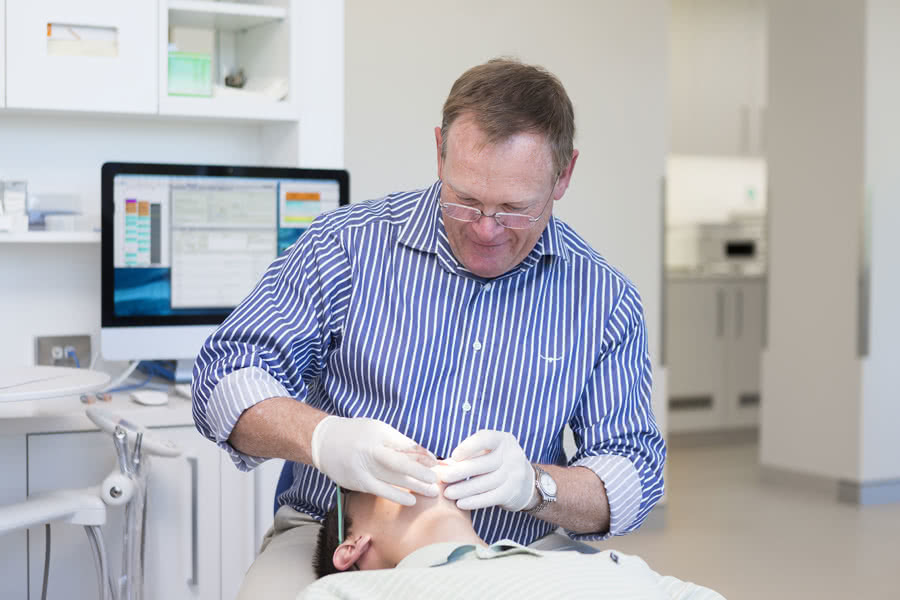
In today’s digital age, having a professional website is no longer a luxury, but a necessity, especially for orthodontists. It serves as the face of your practice online, providing potential patients with a first impression and an insight into your services. A well-designed, user-friendly website can effectively convert site visitors into loyal patients, contributing significantly to your practice’s success.
Creating such a website requires the expertise of a specialized web designer who understands the unique needs and expectations of an orthodontic practice. They should be capable of merging aesthetics with functionality, creating a website that not only looks appealing but also ensures a smooth user experience. From easy navigation to quick loading times, a specialized web designer can make your online presence stand out in an increasingly competitive industry.
Search Engine Optimization (SEO) plays a crucial role in this digital landscape. An orthodontic practice’s visibility online is largely dependent on its ranking in search engine results. A well-executed dental SEO strategy can help your practice appear in top search results, making it easier for potential patients to find you. Hence, it is vital to work with a web designer who has a deep understanding of SEO best practices in the orthodontic industry.
I Want New Patients! Schedule My FREE New Patient Strategy MeetingUnderstanding the Needs of Orthodontic Practices

Orthodontic websites have distinctive needs compared to generic business websites. Besides presenting a professional image, these websites must communicate the services offered, the qualifications of the orthodontist(s), and the benefits of these services to patients. Furthermore, orthodontic websites should inspire trust and create a comfortable environment for visitors, as they can often be nervous or apprehensive about orthodontic procedures.
Key Features and Functionalities Essential for Orthodontist Websites
Certain features are key to the success of an orthodontist’s website. This includes an intuitive layout for easy navigation, high-quality images and videos showcasing the orthodontist’s work, and patient testimonials for social proof. Online booking functionality and a contact form are also essential, making it easy for potential patients to engage with the practice. Additionally, the provision of educational resources about orthodontic procedures can help answer common patient queries, further building trust and credibility.
- Intuitive Layout: A user-friendly design that allows visitors to easily navigate the site, find information, and understand the services on offer.
- High-Quality Visuals: Images and videos that showcase the practice’s work, office environment, and team to help build trust and familiarity.
- Patient Testimonials: Positive reviews and testimonies from past patients serve as social proof, reassuring potential patients about the quality of care.
- Online Booking: A feature for scheduling appointments online enhances convenience for patients and can improve efficiency in the practice.
- Contact Form: An easily accessible form for potential patients to ask questions or request more information.
- Educational Resources: Providing articles, blogs, or FAQs about orthodontic procedures can answer common patient queries, further building confidence and trust in your practice.
- Mobile Responsive Design: Ensuring the website is accessible and functional on all devices, particularly mobile, as a large portion of web traffic comes from mobile users.
- SEO Optimized Content: The website should have content optimized for relevant keywords to improve visibility in search engine results.
- Secure Patient Portal: A secured platform where patients can access their medical records and treatment plans and communicate with the orthodontist.
- Live Chat/Chatbot: A feature for instant communication can provide immediate assistance and answers, further improving the user experience.
The Impact of Responsive Design and Mobile Optimization
In today’s mobile-centric world, having a responsive and mobile-optimized website is critical. A significant proportion of potential patients will likely visit the site on a mobile device. Hence, the site must adapt to various screen sizes while maintaining a user-friendly and aesthetically pleasing interface. This will not only enhance the user experience but also improve the website’s ranking in search engine results, as mobile-friendliness is a key SEO factor.
The Traits of a Successful Orthodontist Web Designer

An effective orthodontist web designer should have two paramount qualities: an in-depth knowledge of the orthodontic industry and proficiency in user experience (UX) and user interface (UI) design.
In-depth Knowledge of the Orthodontic Industry
A web designer catering to orthodontic practices must possess a profound understanding of the industry and its unique requirements. They should be familiar with common orthodontic procedures, industry jargon, and the specific needs of patients seeking such services.
This knowledge is critical in developing content that resonates with the target audience, effectively communicates the offered services, and addresses common patient concerns and queries. Additionally, awareness of industry trends and competitors can help the web designer create a website that stands out and remains relevant in a competitive market.
Proficiency in User Experience (UX) and User Interface (UI) Design
UX and UI design skills are essential for creating a website that is not only visually appealing but also user-friendly and intuitive. The designer must be adept at structuring the website’s layout in a way that facilitates easy navigation, ensuring that patients can find the information they’re looking for with minimal effort.
They should also be able to design visually pleasing elements that align with the orthodontist’s brand image while keeping the interface simple and uncluttered. Furthermore, given the growing use of mobile devices, the designer must be capable of creating a website that delivers an excellent user experience across all platforms and screen sizes.
Researching Potential Web Designers

When it comes to selecting the right web designer for your orthodontic practice, thorough research is essential. Here are some strategies to guide your research:
Utilizing online platforms and directories
There are numerous online platforms and directories where you can find listings of web designers. Websites like Upwork, Freelancer, and Clutch, among others, provide a platform for web designers to showcase their skills and past projects. You can filter search results based on criteria like industry expertise, years of experience, and location. Be sure to take note of designers specializing in medical or dental website design, as they are likely to have a better understanding of your specific needs.
Checking portfolios and case studies
A designer’s portfolio provides valuable insight into their design style, creativity, and technical skills. Look for designers with portfolios that include websites for orthodontic practices or related medical fields. Case studies, on the other hand, give you an understanding of the designer’s process and their ability to solve problems and meet client objectives. A good case study should detail the project’s goals, the steps taken to achieve those goals, and the final results.
Reading client testimonials and reviews
Client testimonials and reviews provide firsthand insight into a designer’s professionalism, reliability, and ability to deliver on promises. Look for reviews that speak to the designer’s knowledge of the orthodontic industry, their ability to meet deadlines, and their responsiveness to client needs. Be wary of designers with consistent negative reviews or no reviews at all. However, remember that one or two negative reviews amidst many positive ones might be an exception and not the rule.
Key Questions to Ask During the Selection Process

When you’ve identified potential candidates for your website design, it’s important to ask the right questions during the selection process. These questions will give you further insight into their expertise, approach, and suitability for your project.
How do you approach designing a website specifically for orthodontic practices? This question will reveal how the designer plans to cater to the unique needs of orthodontic practices. It allows you to assess their understanding of the industry and whether they have a strategic approach to design, considering factors such as user experience, aesthetic appeal, search engine optimization (SEO), mobile-friendliness, and the integration of orthodontic-specific features.
By delving into their methodology, you can gain confidence in their ability to create a website that meets the specific requirements of orthodontic practices, ensuring an effective online presence.
Can you provide examples of successful orthodontist websites you’ve designed in the past? By asking this question, you can assess the designer’s previous work and its effectiveness in the orthodontic industry. Successful examples should demonstrate an understanding of the unique challenges and goals of orthodontic practices, a user-friendly design that enhances the patient experience, and an appealing aesthetic that aligns with the practice’s branding.
Pay attention to key details like site layout, navigation, mobile compatibility, seamless integration of appointment scheduling tools, before-and-after photo galleries, and informative content presentation. Examining these examples will help you gauge the designer’s ability to create a visually appealing and functional website tailored to the needs of orthodontic practices.
Budget Considerations

When investing in web design for your orthodontic practice, it’s essential to understand the cost factors involved and balance the need for quality with affordability. Here are some key considerations:
Understanding the cost factors involved in web design
Web design pricing largely depends on the complexity of the project, including features, customization, and the level of expertise required. Costs typically cover design, development, content creation, SEO, and website maintenance. More complex features like custom graphics, interactive elements, or e-commerce functionality can increase the cost. It’s crucial to understand these factors when setting a budget, ensuring that it aligns with your needs and expectations.
Balancing quality and affordability
While it’s tempting to choose the cheapest option available, it’s crucial to remember that quality and performance are paramount when it comes to your website. Your website is a major touchpoint for potential patients, and a poorly designed or functioning site can negatively impact their perception of your practice. Therefore, aim to balance affordability with quality, considering the value the website will bring to your practice in terms of patient acquisition and retention.
Negotiation strategies when discussing pricing with potential designers
When discussing pricing with potential designers, be upfront about your budget and ask for a detailed breakdown of costs. This transparency allows you to understand exactly what you’re paying for and provides room for negotiation. If a quote exceeds your budget, ask if there are areas to scale back on or if there are payment plan options. Always remember to negotiate terms that do not compromise the quality or functionality of your website.
Establishing Clear Communication and Expectations

Importance of Transparent Communication
Transparent communication forms the bedrock of any successful project. It ensures that both parties are on the same page in terms of project expectations, goals, and objectives. For a web design project, it facilitates a smooth process by fostering an environment where ideas, concerns, and changes can be freely discussed. This open communication helps avoid misunderstandings, prevent delays, and ensure your website aligns with your vision.
Setting Clear Expectations and Timelines
Establishing clear expectations at the outset of the project is instrumental in guiding its progress and outcome. It entails defining the scope of work, outlining specific deliverables, and setting a realistic timeline for completion. This not only provides a roadmap for the designer but also sets benchmarks against which you can measure progress. Timelines should take into account all phases of the project, from initial concept development to final launch, ensuring you have a comprehensive overview of the project duration.
Regular Updates and Feedback During the Design Process
Regular updates and feedback are essential elements of the design process. They allow for real-time tracking of the project’s progress, offer opportunities to provide feedback and ensure the final product aligns with your vision. It’s important to have a system for regular check-ins with the designer, where you can review the work, discuss any changes, and address concerns. This collaborative approach ensures your vision is accurately translated into the design and any potential issues are promptly addressed, contributing to a successful project outcome.
Incorporating SEO Best Practices
On-page SEO Optimization for Orthodontic Websites
On-page SEO optimization is crucial in improving the visibility and searchability of your orthodontic website. This process involves optimizing various elements on your site, such as title tags, meta descriptions, header tags, and content, to make it more attractive to search engines. Including relevant keywords in your content, URL structure, and image alt text can greatly enhance your site’s SEO. Regularly updating your website with fresh, quality content can also help improve its ranking on search engine results pages (SERPs).
Importance of Keyword Research and Implementation
Keyword research plays a pivotal role in SEO strategy. It involves identifying the words and phrases that potential patients use when searching for orthodontic services online. By incorporating these keywords into your website content, you can improve your site’s relevancy to these search queries, increasing the likelihood of appearing in the SERPs. There are various online tools available for keyword research, helping you identify high-volume, low-competition keywords that can drive targeted traffic to your site.
Mobile-Friendliness and Site Speed Considerations for SEO
In this digital age, ensuring your website is mobile-friendly and fast-loading is essential for SEO. With a majority of users accessing websites from mobile devices, search engines like Google prioritize mobile-friendly sites in their rankings. Moreover, site speed significantly impacts user experience. Slow-loading pages can lead to high bounce rates, which can negatively affect your SEO. Therefore, your site should be designed with mobile users in mind, and regular site speed tests should be conducted to ensure optimal performance.
Finalizing the Decision and Moving Forward
Evaluating the Gathered Information and Making an Informed Decision
After collecting all relevant information, it’s pivotal to take the time to evaluate each aspect thoroughly. This includes reviewing each web designer’s portfolio, pricing, communication style, and understanding of SEO best practices. Prioritize the elements that are most important to your practice’s needs and goals. Consider the value each designer offers concerning their costs and the potential return on investment they could provide. This comprehensive evaluation will help you make an informed decision about which web designer is the best fit for your orthodontic practice.
Steps to Initiate the Collaboration with the Chosen Web Designer
Once you’ve made your decision, it’s time to initiate collaboration with the chosen web designer. Start by setting up a kick-off meeting to solidify the project’s details, timelines, and deliverables. In this meeting, ensure to discuss the specifics of your vision for the website and any unique features you want to include. Following this, arrange a regular schedule for updates and feedback sessions to maintain transparency and ensure effective communication throughout. Finally, sign any necessary contracts or agreements to formalize the collaboration.
The Significance of Ongoing Support and Maintenance
Maintaining your website post-launch is as crucial as the design and development phases. Ongoing support and maintenance encompass regular updates, security checks, and performance optimizations to ensure your site continues to function optimally and stays up-to-date with the latest web standards and SEO practices. This ongoing care can help you maintain a positive user experience, boost your site’s search engine rankings, and, ultimately, increase patient acquisition and retention. Therefore, it’s imperative to choose a web designer who offers reliable ongoing support and maintenance services.
Conclusion
In conclusion, finding the right web designer for your orthodontic practice involves a strategic and thorough process. This includes setting clear expectations and timelines, seeking regular updates, and providing feedback during the design process, as well as ensuring the implementation of SEO best practices. Finally, the decision should be based on a comprehensive evaluation of the designer’s portfolio, their understanding of SEO, and the potential return on investment. The collaboration doesn’t end with the site’s launch; instead, it continues with regular maintenance and support to ensure optimal performance. By adhering to these key points, you will be better equipped to find a web designer who can effectively translate your vision into a tangible, successful web presence for your orthodontic practice.
I Want New Patients! Schedule My FREE New Patient Strategy Meeting